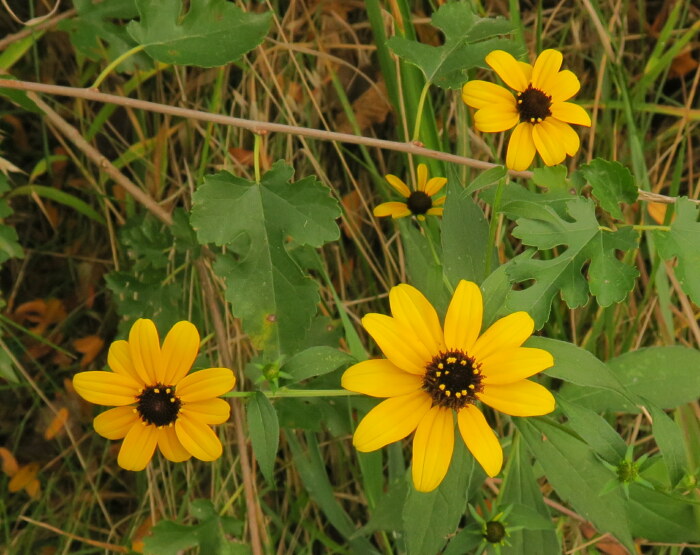Most Iowa wildflowers have gone to seed by now. But I’m always intrigued by the plants that keep blooming long after others. So I ventured out on yet another unseasonably warm day to photograph late bloomers in the prairie planting along the Windsor Heights trail, immediately behind the Iowa Department of Natural Resources building on Hickman Road.
I’ve been impressed by how well this patch has been managed over the past decade or so. It’s mostly free from the invasive plants that took over the onetime Eagle Scout project about a quarter-mile away on the Windsor Heights trail (near where Rocklyn Creek runs into North Walnut Creek).
The patch behind the Iowa DNR building is most colorful over the summer, but I enjoy watching the succession of wildflowers blooming, from golden Alexanders in the spring to rosinweed and wild bergamot in the summer to the last of the asters in the fall. There’s plenty of parking near the building, if you can’t access the area on foot or by bicycle. The Windsor Heights trail is paved and flat, for those who struggle with uneven ground.
I took all of the photos enclosed below on October 4.
Asters tend to be the star of the show in the fall. I may need to come back and correct some of the labels later, depending on what I learn from knowledgeable folks in the Iowa wildflower enthusiasts Facebook group.
I’m fairly confident about this one: New England aster. Diane Porter recently featured these on her email newsletter, which I highly recommend for nature lovers.

Based on the feel of the leaves, I think these are smooth blue asters. The flowers are virtually indistinguishable from sky-blue asters (at least for me).

The asters with white and yellow flowerheads are notoriously tricky to identify. I think these are frost asters. Correction: Lora Conrad has convinced me that due to the lack of hairs on the leaves and stems, these are more likely panicled asters.

Another look from the same area.

I think this bushy plant with smaller leaves and flowerheads is a heath aster.

More frost asters? Or maybe calico asters or panicled asters? UPDATE: According to Lora Conrad, these cannot be calico asters because there are too many ray florets per flowerhead. Tentatively I will identify these as panicled asters.

Goldenrods can be just as difficult to distinguish as asters. I believe these next two photos depict showy goldenrod.


The panicles on this next plant don’t look flat enough to be Canada goldenrod. The flowers seem smaller than those on the Missouri goldenrod that was planted about a half-mile away near my alma mater, Clive Elementary School (now known as the Clive Learning Academy). It seems too late in the year for this to be early goldenrod. I’ll update if someone has the answer.

Here’s a different group of goldenrods.

This looks like a different goldenrod, but again, I am stumped.

This rough blazing star was growing sideways and still had a few colorful flowerheads. (I think the large dark seedhead near the right edge of this photo is a pale purple coneflower.)

Speaking of coneflowers, one gray-headed coneflower was still blooming near others that have gone to seed.

Right next to the building, one last flower remains open on a compass plant. (Letter carriers often train in this parking lot, which is why you see the cones and mail trucks in the background.)

I was surprised to see so many blossoms on a flowering spurge this late in the year. You can see many three-part green seed capsules developing as well.

I think this was a purple prairie clover, although it didn’t have the distinctive cone-like shape.

Lots of partridge pea plants were blooming here a couple of months ago, but only a few still had flowers today.

A lone common sneezeweed flower was surrounded by seedheads of those that bloomed before.

I did find a few more of these still blooming.

I also found a few flowers on common evening primrose plants.

Although I forgot to photograph the bracts that could have confirmed the ID, I believe this solitary white flower is part of a hedge bindweed vine wrapped around the stems of other plants.

To my knowledge, these are brown-eyed Susan flowers. (This prairie patch has some black-eyed Susan too, but I think those are done for 2023.) Brown-eyed Susan plants look much bushier near the peak of the blooming period, and the flowerheads have fewer yellow ray florets than black-eyed Susan.

Prairie plants dominate the patch behind the DNR building, but many woodland plants also thrive next to the Windsor Heights trail, which runs through the “Colby Woods” area along North Walnut Creek. A few white snakeroot plants, which thrive near woodland edges, were still flowering today.



1 Comment
So nice to see these blooms in October -- thank you, Laura Belin!
And cheers for the people who are doing a good job of managing the DNR prairie planting. Good managers of natural areas, original and restored, public and private, are the caretakers of Iowa’s surviving natural heritage. They deserve gratitude from all of us who care about that heritage.
And to the organizations and institutions and individuals who ensure good continuous management of many fortunate natural areas, thank you! The differences between a cared-for piece of land and an ignored piece of land can be dramatic.
PrairieFan Fri 6 Oct 10:42 PM